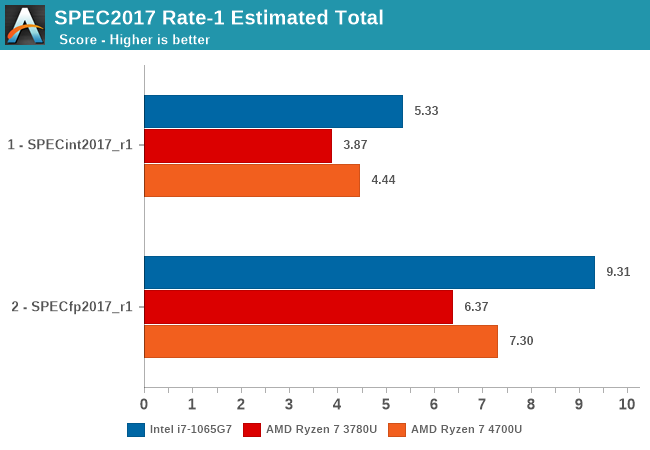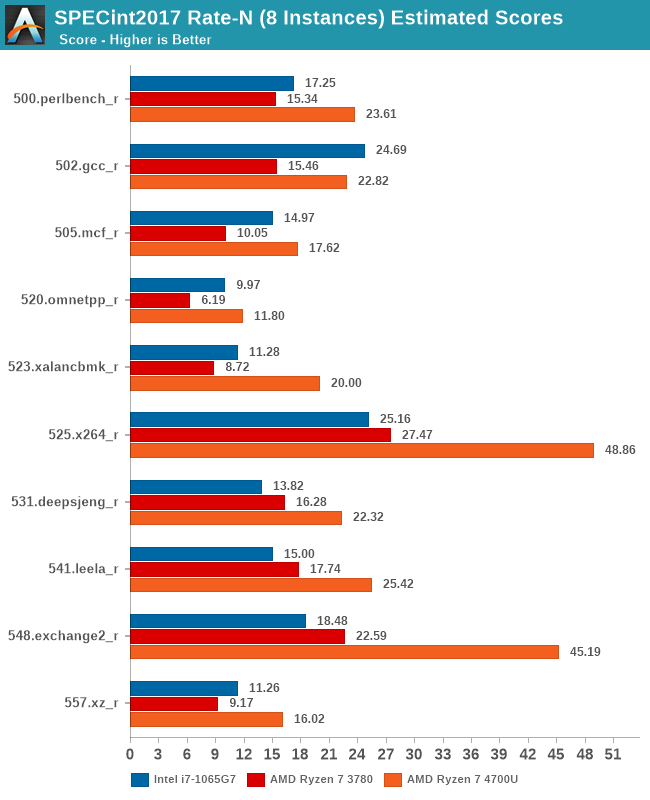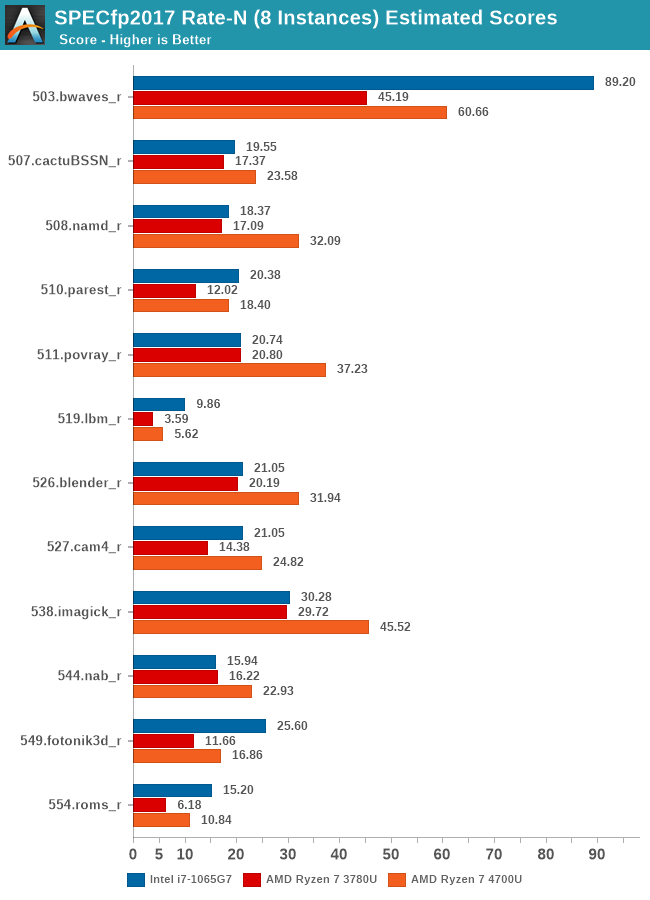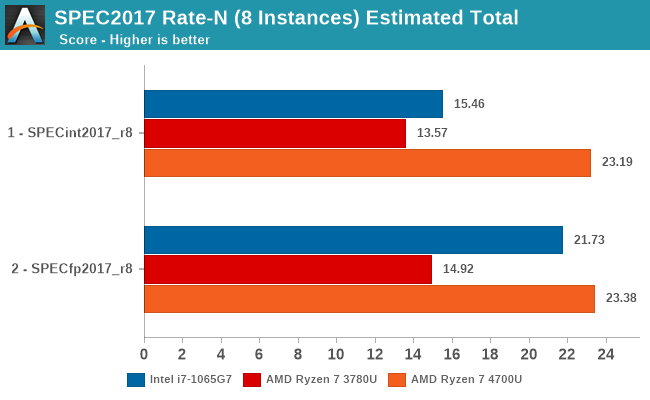The Acer Swift 3 SF314 Notebook Review: Swift Gets Swifter With Ryzen 4000
by Brett Howse & Andrei Frumusanu on May 5, 2020 8:00 AM ESTSection by Andrei Frumusanu
SPEC: Renoir vs Picasso vs Ice Lake
Kicking off our look at performance, let's start with SPEC and analyzing how AMD managed to increase the performance against Picasso with its first-generation Zen cores. The newer generation Renoir with Zen2 cores should in theory see more significant performance upgrades thanks to the improved IPC of the new microarchitecture – but today’s 4700U also is just a mid-tier part with a lower 15W TDP as well as “just” featuring DDR4-3200 – not the fullest memory configuration possible as the SoC also support LPDDR4X up to 4266 MHz.
For our SPEC harness, We’re testing under WSL1 in Windows due to simplicity of compilation and compatibility, and are compiling the suite under LLVM compilers. The choice of LLVM is related to being able to have similar code generation across architectures and platforms. Our compiler versions and settings are as follows:
clang version 8.0.0-svn350067-1~exp1+0~20181226174230.701~1.gbp6019f2 (trunk) clang version 7.0.1 (ssh://git@github.com/flang-compiler/flang-driver.git 24bd54da5c41af04838bbe7b68f830840d47fc03) -Ofast -fomit-frame-pointer -march=x86-64 -mtune=core-avx2 -mfma -mavx -mavx2
Our compiler flags are straightforward, with basic –Ofast and relevant ISA switches to allow for AVX2 instructions.
Single-Threaded Performance

In SPECint2017, the new Zen2 based Ryzen 7 4700U is performing well, although the score increase compared to the last-generation 3780U aren’t as big for some workloads. As a reminder, the 3780U clocks up to 4.0GHz in terms of boost clocks while the 4700U clocks up to 4.1GHz. SMT being disabled on the 4700U should also give it a slight advantage in IPC over other Zen2 platforms given that it doesn’t have to statically share some core resources anymore in this mode.
Renoir showcases the biggest increases in workloads such as 548.exchange2_r and 525.x264_r which are back-end execution bound workloads, and the microarchitectural improvements here help a lot.
On the other hand, the weakest improvements are seen in workloads such as 520.omnetpp_r – this test is mostly memory latency bound and unfortunately the new chip here barely just matches its predecessor. The same can be said about 505.mcf_r where the improvements are quite meager.
The generational improvements here aren’t enough to catch up to Intel’s Sunny Cove cores in the Ice Lake i7-1065G7. Although that core might be running at higher single-core TDPs and power consumption, it still makes for a big gap in some of the more instruction pressure and cache pressure high workloads such as 500.perlbench_r and 502.gcc_r where the Intel chip still has a considerable lead in.

In SPECfp2017, these are floating point heavier test workloads. The generational increases here are also relatively smaller, with even an odd regression in 527.cam4_r. The Intel chip still has a lead across the board, and with particular large gaps in the more memory heavy workloads such as 519.lbm_r and 549.fotonik3d_r.

Overall, in terms of single-threaded performance, the Zen2 Renoir chip might seem a bit underwhelming, but when looking at the IPC improvement it’s actually not that far off from what’s expected of the new microarchitecture. In both SPECint and SPECfp we see a 12% performance per clock improvement, which is generally in line with Zen2’s generational improvements. As a reminder, the mobile chips here only feature a quarter the CCX L3 cache compared to its desktop counterparts, and that will result in smaller IPC gains, especially in memory heavy workloads.
AMD’s higher-end SKUs such as the 4900HS score slightly better due to the higher boost frequencies, but nothing significant enough to change the single-threaded competitive landscape; Intel still has a substantial advantage here thanks to a much stronger memory subsystem.
Multi-Threaded Performance
The multi-threaded performance comparison today is actually quite interesting just for the fact that the 4700U doesn’t feature SMT. Whilst it lacks multi-threading on the cores, it makes up for it by simply having 8 physical cores on the chip, double that of Picasso-based SoCs as well as Intel’s latest Ice Lake CPUs. Again, performance here will be strongly impacted by the TDP as well as cooling of the systems. Both AMD parts are 15W TDP designs, while the Intel chip sustains 25W.

The resulting multi-threaded performance is quite varied across the benchmarks. What immediately stands out is that in purer execution heavy workloads the new Renoir chip pretty much demolishes its predecessor as well as the competition. This makes sense given that Zen2 has good execution resources and Renoir has double the physical core count to scale up performance.
Renoir’s performance here is very good across most workloads, but there’s a few workloads where Intel’s Ice Lake CPU comes closes or beats it even (502.gcc_r) – again these are the workloads that are most memory intensive.

SPECfp across 8 instances again shows similar results. Renoir fares extremely well across execution bound workloads, but this time around loses a lot more often against the Ice Lake chip in memory-bound workloads even though it has a 2x core count advantage.
The chip’s performance in memory-bandwidth heavy 519.lbm_r is particularly odd as it manages to fare worse than single-core results of a desktop Zen2 based system, and again far behind the Ice Lake counterparts.

Overall, AMD’s 4700U’s multi-threaded performance is fantastic in areas where it should matter most in a laptop-based system. The 2x core count advantage more than makes up for the lack of SMT, and workloads such as rendering and other creative tasks are the platform’s strong-points. In more memory-heavy workloads, performance doesn’t scale all that well as clearly the new chip still has a big weakness in its memory subsystem – scientific workloads or code compiling won’t scale nearly as well.
We have to wonder how Renoir will fare on an LPDDR4X configured system – unfortunately we haven’t been able to test such a platform yet. Overall, the 4700U seems like an excellent chip given its 15W TDP, but let’s see how it performs in our system benchmark suite…










191 Comments
View All Comments
fmcjw - Tuesday, May 5, 2020 - link
Because over in Mac land they finally got the butterfly keyboard revolt over with and now talks can resume on the finer points of systems design. But it's not looking good for fine arts because the front burners have been conscripted for the A15 (MacOS on ARM) revolution.Spunjji - Wednesday, May 6, 2020 - link
Buying a CPU that doesn't have turbo is *not* a worthy trade-off unless you simply cannot afford anything better, because you'll be leaving a whole ton of performance on the table - especially when the device is plugged in.The 25% battery deficit isn't as simple as "more cores, more power" either - check out the Zephyrus G14 vs the Razer Blade 15 for a more appropriate comparison of well-designed devices. Put simply, that deficit has more to do with how this particular notebook was designed than it does to do with Ryzen 4000.
Focusing on single-thread performance when the vast majority of applications users interact with are multi-threaded doesn't really make sense, either. I'd recommend reading in a little more depth.
Omega215D - Tuesday, May 5, 2020 - link
Looks like we've got another piece of crap Intel fanboy here intent on spreading FUD on AMD's new mobile processors. So far reviews of the ASUS TUF featuring the new procs do far better on battery life and gaming performance.yeeeeman - Tuesday, May 5, 2020 - link
Looks like we've got another piece of crap AMD fanboy that cannot read the damn graphs.yankeeDDL - Tuesday, May 5, 2020 - link
The XPS and the Surface cost about twice as much as the Swift 3: they are high-end systems with high-end components, especially screens.Irata - Tuesday, May 5, 2020 - link
Actually the Dell's "as reviewed" price on At was $ 1,749.99, the Surface Laptop 3 with a 512GB SSD costs $ 2,199, so we are talking three times the price. The Yoga C930 is almost budget, costing only slightly less than twice as much as the Swift.yankeeDDL - Wednesday, May 6, 2020 - link
Thanks. You're right of course.Irata - Tuesday, May 5, 2020 - link
Eight cores vs. four cores....You have surely seen the battery life comparisons between Ryzen 4000 and Intel's eight core counterpart.
notb - Wednesday, May 6, 2020 - link
Number of cores is of less importance. Intel makes 16-core processors using 30W and 6-core chips using 100W.Comparison of 8-core SoCs are between chips made on TSMC 7N and Intel 14nm, which makes AMD much more efficient.
This comparison is for TSMC 7N vs Intel 10nm.
What matters is performance vs power and average these are similar. The gap will be minimal when Intel launches 6 or 8-core models later this year.
Spunjji - Wednesday, May 6, 2020 - link
Is there any evidence that Intel will be releasing 10nm 15W 6-8 core CPUs this year? I thought they were sticking with 4 cores on 10nm and releasing 6-8core 15W 14nm CPUs.